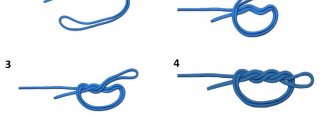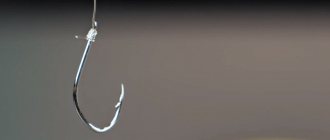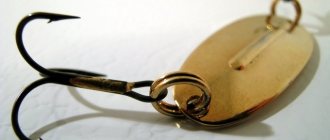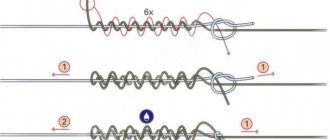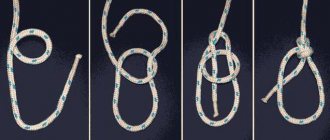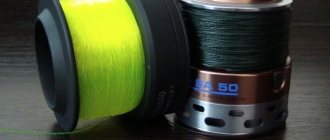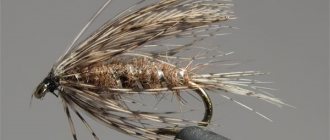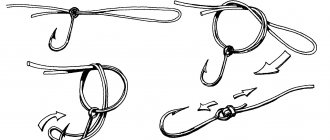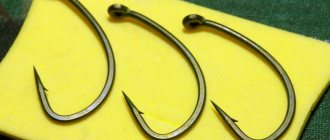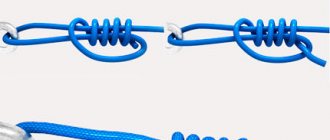Application of nodes
Various loops and knots can be used for fishing. There are complex and simple fastenings. There are situations in life when you have to use nodes of varying levels of complexity.
When fishing from a boat, you may encounter unforeseen circumstances. As an example, consider these:
- Monofilament or braid tied very loosely She may drown when trying to reach it using the end of the braid. If the cast is not made over a very long distance, then there is a chance that you will find it from the shore. But it will be almost impossible to do this from a boat.
- Another example could be this. A loosely tied fishing line will be torn off by a boat passing by. What will happen in this case? If the knot were strong, the fishing rod or spinning rod would simply fall out of your hands and drown. But weak fasteners, in this case, will save your fishing rod and reel. And the fishing line will never be returned. Therefore, in this example you will incur minimal losses.
Self-tightening fishing knot for connecting fishing line with a bait loop or swivel
Another option for a braided knot is an entertaining self-tightening knot.
Fishing knots perform a very important task and yet they are the most unreliable elements of gear. Unfortunately, it is impossible to do without them. There is no gear without knots, and there are at least two of them in it: the first in connection with the rod, the second for connecting the hook or bait to the fishing line.
Types of fishing knots
Spinners often use three knots or even more. Below are the types of fishing tackle knots. Studies of the characteristics of fishing line have proven the fact that knots have a negative effect on strength qualities; only one knot reduces them by 20%. Cords and hard fishing lines can withstand knots much better than soft fishing lines, but they are the least suitable for equipping a spinning rod. So it turns out that ordinary spinning tackle is two times weaker than one would expect.
We thread the braid, pull it over our fingers (Fig. 43-61), make another loop and begin to wrap the fishing line with the free end towards the domestic bait or whatever we are tying the fishing line to.
Rice. 43-61 Make 7-8 turns and thread the free end of the fishing line into the loop (Fig. 43-62).
Rice. 43-62 To prevent the braid from coming apart, we once again thread the fishing line into the newly formed loop. Wet and tighten (Fig. 43-63).
Rice. 43-63 Such a knot is optimal in that, if necessary, we can pick it up and move it apart (Fig. 43-64). But it won’t come apart on its own, because it holds together perfectly. We pull him - he again approached the bait. In some cases, when we need a reliable movable knot that does not unravel, this knot works great.
Rice. 43-64 This knot can be knitted, like the previous one, on a double fishing line, so it will have significantly greater reliability.
How to tie a leash (second) to the main fishing line. Fisherman fisherman. Fishing
Knots. Fisherman's Knots. Non-slip monoloop knot. Encyclopedia of Knots. Fishing gear
How to tie fishing line to a reel
Non-professional fishermen very often ask the question of what should be the amount of fishing line wound on the spool. But professionals say that it is necessary to wind until the distance from the side is approximately 2 mm. This will give you the maximum number of casts. Do not wind the line to the level of the side of the reel. This can lead to beards and ring sheds.
When winding, you should adhere to the following tips:
- If the reel you purchased is small, you can completely wind the line around it. It will fit entirely into the reel seat.
- If the reel is capacious , then you don’t have to skimp on the amount of fishing line on it. This only applies to inexpensive monofilament. Otherwise, such winding can cost you a large sum of money.
- If you have chosen an expensive type of fluorocarbon or braid, then in order to save money, you can first wrap electrical tape or adhesive tape on the spool, and only then go directly to the expensive type of material.
- You can also use backing to save money - this is a cheap type of material used for winding. Tie this backing to expensive material and wind it first.
Crocheting methods
For tying hooks, knots are used that are compact and have the least disruption of strength at the connection point. These requirements are due to the fact that it is usually necessary to use the thinnest line possible to increase the chance of a fish biting. In addition, the type of thread used imposes its limitations.
Simple eight
Used for tying hooks with a spatula. Not the most outstanding strength is compensated by its “omnivorousness”, which allows you to knit both monofilament and braid:
- Fold the thread in half.
- Pass the free end through the resulting loop twice.
- Holding the opposite edges of the loop with both hands, turn them in the diametrically opposite direction in relation to each other.
- Pass the hook through the resulting figure-eight shape.
- Tighten the resulting knot, not forgetting to wet it first.
Popular doomhof
Its strength and versatility are rightfully appreciated by many. Used both for hooks with a blade and for hooks with a ring, on different types of fishing line:
- Fold the fishing line in half on the shank of the hook in the direction from the blade, forming a half-loop.
- Holding the resulting loop and the bend of the hook with one hand, use the free end of the fishing line to make 5-6 turns around the shank and the fishing line lying on it. Turns can be made both in the direction of the blade and in the direction of the bend of the hook. The main condition for obtaining a high-quality assembly is that all turns must be strictly consistent, and not randomly.
- Pass the free end through the loop.
- Smoothly tighten the structure, after wetting it.
Wetting the knot with saliva or water is done to reduce damage to the line due to the heat generated when tightening.
Bayonet knot
Used when crocheting braided yarn. Not suitable for monofilament line:
- Pull the end of the braid through the eye of the hook.
- Make one turn of the fishing line around the shank so that its end passes under the main fishing line (from the side of the hook ring).
- Make another turn around the forend, following the same rules.
- Tighten the knot, remembering to wet it.
Monofilament is not suitable for a bayonet assembly due to the fact that it can slide at the connection point. This can lead to decoupling. This type of fishing thread also significantly loses strength in the area of the connection, which can lead to breakage of the tackle.
Clinch with high reliability
Its modern version is designed for knitting monofilament threads with a thickness of no more than 0.4 millimeters. Strength with proper bonding quality reaches 97%:
- Thread the line through the eye of the hook and fold it in half.
- With its free end, make 6-7 turns around the main fishing line, moving 0.5-1 centimeter away from the hook, and moving in the direction from it.
- Return the free end and pull it through the resulting loop near the hook.
- Move the free end of the line in the opposite direction and thread it through the last turn, moving in the same direction as the main thread.
- Carefully tighten the connection, remembering to wet it, holding the coils and hook with one hand and tightening the knot with the other.
The clinch is not suitable for braid and fluorocarbon due to the possibility of it coming undone.
Unique in strength Jansik
A complex knot, characterized by unprecedented strength - about 100%. The difficulties of knitting it are due to the fact that you have to tighten it in three directions at once. The connection is used for tying hooks and various baits to monofilament fishing line:
- The fishing thread is pulled through the eye of the hook.
- The free end of the fishing line is pulled through the hook ring three times in the same direction, forming three identical loops.
- Then the free end is pulled through the resulting loops three times.
- The knot is carefully tightened. Care must be taken to ensure that all components are tightened evenly.
When knitting Jansik, it would be advisable to secure the hook either in a vise or in some other way. The process will be facilitated by a regular knitting needle, which can be inserted into the rings to tighten them evenly.
Lightweight and versatile palomar
An easy-to-learn knot that is highly durable . With its help you can attach both a hook and a swivel, or a jig bait. Its downside is that not every hook is suitable, but only one that has a ring of sufficient width:
- Fold the fishing line in half to make a loop about 5 centimeters long.
- Pull the resulting loop through the eye of the hook.
- Using a loop and the main fishing line folded in half, tie a regular knot so that the hook with the fishing line threaded through the eye is in the middle.
- Cross the loop over the bend of the hook.
- Carefully tighten the connection.
How to tie a loop correctly
There are an incredibly large number of nodes. But it’s not enough just to know how to tie their different types. It is necessary to perfect the tying technique. To do this, constant training is required.
Here are some tips on how to knit stitches correctly:
- tie loops while watching a TV show;
- Use pliers rather than teeth for this process;
- When tying the fishing line onto the spool, the knots should not stretch;
- The loop should be at the bottom of the bobbin. This will ensure minimal contact with the fishing line;
- the fishing line to the reel in a way that is more convenient for you.
To avoid unforeseen situations, it is necessary to tie all loops, observing safety requirements.
- All knots must be untied without any effort, regardless of the condition of the rope;
- select it based on what you are going to use it for;
- The knot must be resistant to tearing and untying;
- The rules for tying a knot must be strictly followed.
Self-tightening knot
This knot is the most original of all types. This type of knot is tightened under the influence of loads, therefore, the greater the load on it, the stronger it becomes.
There are many tightening sea knots. But among fishermen, the one that can be used for bottom fishing using a capacious reel is more popular. A large diameter reel with a fishing line wound around it will help you make a big cast.
How to tie this type of knot
- To begin, wrap a rope around the spool. To make this material comfortable to hold, you need to leave the tip a little longer.
- Next, the tip of the fishing line needs to be turned into a loop. To do this, wrap the pre-leading line and turn the tip in the opposite direction.
- Guide the free end into the loop that is at the base of the twist. Next, moisten the fishing line with any liquid and tighten the knot. Place the self-tightening loop on the spool and tighten. You need to pull on the main line.
- The rope will tighten on its own . The ends that stick out must be removed using scissors or a knife.
- Such a loop turns out to be sliding. Therefore, if the need arises, you can easily untie it and free the spool from it.

